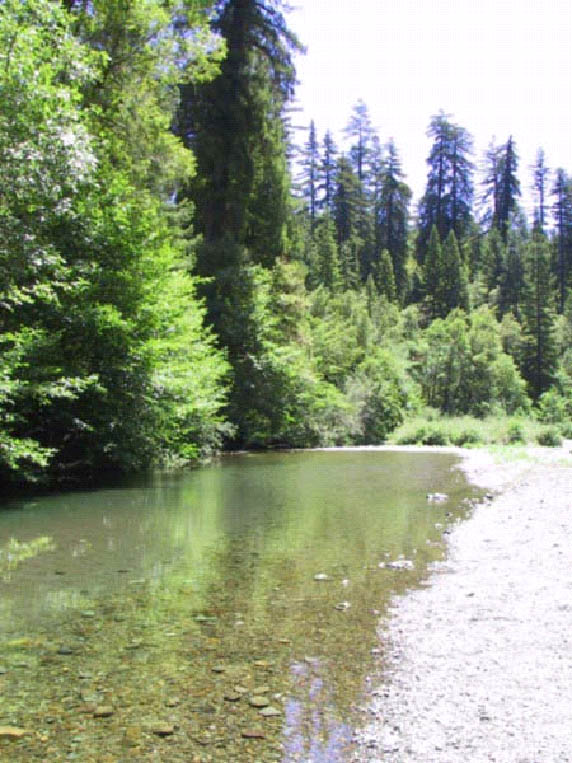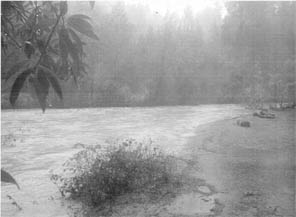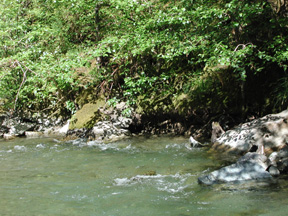
|
The Riparian Biozone
First posted February 1, 2004
Last updated November 15, 2011
| Cazadero Performing Arts
Camp lies along Austin Creek. If you
walk along the creek, you will quicky see how
different this area is from the areas around the dining hall, tents, and the Lutt Family Ampitheater.
The ground is level and stony and bare, not at
all like the redwood area, which is steep in many
areas and covered with leaf litter. The creek area is often hot in the bright sunshine of the summer, while the redwoods are much cooler. The creek
area always has water present, and water is the
main determining force for all the plants and
animals that you find along the creek. Water,
along with the climate and soil conditions, defines
a plant and animal community called the Riparian
Biozone. Although it is just a few feet
away from the redwoods, the riparian zone of Caz
is very different from it. However, it is fairly similar
to that of any other riparian biozone of any other
biome in California, from northern border to southern
border, and from mountain to shore. |
 |
Water
 |
Water is what defines the riparian zone ("riparian"
means "river".) The river in winter
covers almost all of the riparian zone. Here is
Austin Creek in the winter of 2004, just after
the torrential rains of January. This is a view
of the river, looking downstream from near the baseball backstop, with the campfire
area just under the water's edge. The baseball
diamond would be just off to the right. During
the winter floods, the river scours the riverbottom
with gravel and rocks, distributing them along
the bed in new formations each year. The willows
and berry bushes that we see in the creekbottom
during the summer are entirely underwater and
being battered to pieces by rocks carried by the
force of the water. The force of the water is
so great it can wash out even steel bridges!
This is the time of year that the salmon move
upstream to spawn, and the other underwater river
creatures simply try to hide from the "underwater tornado"
of the floodwaters. |
The water in summer is another defining force in the
riparian zone. As you can see from the photograph at
the top of the page, in summer the river flow is very slow, and
in some places the river is entirely underground. The stones,
washed clean of any lichens, mosses, or plants, lie
strewn about the riverbed, silent testimony to the power
of the winter's ravages. The trout and many aquatic
insects are very stressed, as the water temperature
rises, causing a fall in the dissolved oxygen in the
stream. This is called a "climatic pessima",
a time of the year that is the hardest on these aquatic
lifeforms, killing many in very dry years.
If you are interested in the current or past river
level, click here for the
California Department of Water Resources online river
level of the Russian River at Guerneville.
All of the plants growing in the
riparian zone need to be adapted to both the water's
excesses in winter and the scarcity in summer. The redwoods
cannot tolerate having their roots stripped of
soil or submerged under water, so none grow in
the annual floodzone. The willows have deep roots
that penetrate well between the rocks and prevent
them from being pulled from the ground, and they
need the water that flows during the summer deep
under the riverbed. The willows, therefore, are
only found in the riverbed. (Note: while willows are naturally found in many streambeds, these were planted by William Mason Holmes (trumpet, SF Opera and a PhD in forest ecology) at the request of Bob Lutt, the founder of the camp, in about 2000 to help stabilize the riverbed near the kitchen and the baseball diamond. He also installed the boulders found just upstream of the kitchen, at the baseball field, and just downstream of the field. If you examine them closely, you will see that they are cabled together so that they do not wash away at high water.)
|
 Mountain
Alder at river's edge,
below Family Camp |
Examine the branches of the willows and you will see the effects of the force of the river, and whatever logs or rocks are swept along with it. Look closely and you will see twigs of trees from far upstream, lichens that floated down, and plastic trash swept from human carelessness into the trees. The berry bushes, wild grape, and wild pea usually invade from the sideline of the river, but cannot survive in the path of the river's fury.
Along the sides of the riverbed, you will see plants that need a lot of water but cannot grow in the riverbed itself. Mountain alder is the principle tree you see, with some big leaf maples sprinkled in.
Notice the redwoods are all a bit further back from
the riverbed. The tallest of our redwoods, however,
grow on the level ground that is the highwater mark
of the centuries, or the streambed of the river from
ages ago. Redwoods need a lot of water and they have
very shallow roots. In addition, redwoods up the side
of the canyon are subjected to higher wind forces in
the winter. These natural forces trim out some of the
redwoods. This is why the tallest (oldest) redwoods
are away from the river, but not too far away.
The animals of the riparian zone are also adapted to
the water, some to its winter maelstrom (the salmon),
and some to its summer sleepiness. Ducks and merganzers
swim along, looking for fish. Newts swim in the slower
areas of the river, looking for aquatic insects. Toads
abound along the dry gravel at river's edge, as most
of the little boys of camp know. They were just hatched
from tadpoles and are scrounging for spiders and very
small insects. If they survive the herons and ducks,
they will hide in the foliage and make their way to
higher ground. Aquatic insects specialized in hiding
under stones are found everywhere, but principally in
areas with current. The rapid flow provides a higher
oxygen content, essential when the heat decreases the
amount of dissolved oxygen. If you turn over stones
in the area where the river seems dry but between pools,
you will discover insects and frogs. They live below
the bottom of the stream, in the area called the hyporheic
zone, an entire world of organisms we usually
completely overlook. Turn over a few stones if you want
to enter into an entirely new world at Caz!

Other Biozones:
Redwood Forest
Oak Woodland Biozone
Chaparral Biozone
Grasslands Biozone
|

|

